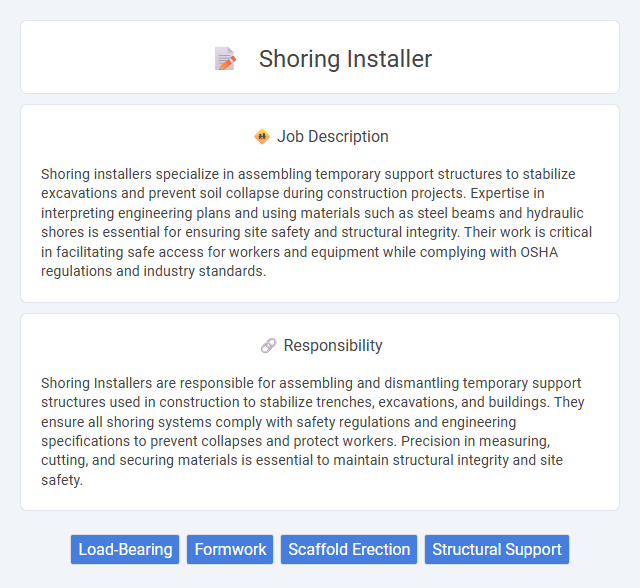
Shoring installers specialize in assembling temporary support structures to stabilize excavations and prevent soil collapse during construction projects. Expertise in interpreting engineering plans and using materials such as steel beams and hydraulic shores is essential for ensuring site safety and structural integrity. Their work is critical in facilitating safe access for workers and equipment while complying with OSHA regulations and industry standards.
Individuals with strong physical stamina and a tolerance for working in outdoor and sometimes hazardous environments will likely be suitable for a shoring installer job. People who are comfortable with manual labor, attention to safety protocols, and working at construction sites may find this role appropriate. Those with medical conditions affecting mobility or endurance might have difficulty performing the required tasks efficiently.
Qualification
Shoring Installer positions require expertise in assembling and securing temporary support structures to ensure the safety and stability of construction sites. Candidates typically need a high school diploma or equivalent, with specialized training or certification in shoring systems and safety protocols. Practical experience with heavy machinery, blueprint reading, and adherence to OSHA standards significantly enhances job qualifications.
Responsibility
Shoring Installers are responsible for assembling and dismantling temporary support structures used in construction to stabilize trenches, excavations, and buildings. They ensure all shoring systems comply with safety regulations and engineering specifications to prevent collapses and protect workers. Precision in measuring, cutting, and securing materials is essential to maintain structural integrity and site safety.
Benefit
Working as a Shoring Installer likely offers the benefit of high demand in construction projects, providing job stability and consistent work opportunities. The role may also come with the advantage of gaining specialized skills in safety and structural support systems, which could increase employability and earning potential. Additionally, the physically active nature of the job might contribute to improved fitness and a dynamic work environment.
Challenge
Shoring installers face the probability of encountering unpredictable ground conditions that require quick adaptation and problem-solving skills. The challenge often lies in ensuring structural stability while working under tight deadlines and strict safety regulations. Successfully navigating these obstacles demands a high level of technical knowledge and precision.
Career Advancement
Shoring installers gain specialized skills in erecting temporary supports for excavation and construction sites, leading to career growth in heavy civil and construction engineering fields. Mastery of safety protocols and advanced shoring techniques opens pathways to supervisory roles such as site foreman or project manager. Certifications in structural safety and occupational health further enhance opportunities for leadership positions within construction management.
Key Terms
Load-Bearing
Shoring Installers specialize in the assembly and reinforcement of temporary structures that support load-bearing elements during construction or excavation. Their expertise ensures stability and safety by preventing structural collapse through the precise placement of shoring systems designed to withstand heavy loads. Mastery of load distribution principles and material strength is critical for maintaining the integrity of load-bearing walls and frameworks throughout the project lifecycle.
Formwork
Shoring installers specialize in erecting temporary support structures that stabilize formwork during concrete construction, ensuring safety and structural integrity. Proficiency in reading blueprints and operating heavy equipment is essential for precise alignment and load distribution. Expertise in materials such as steel props, timber beams, and hydraulic jacks enhances the efficiency and durability of shoring systems.
Scaffold Erection
Shoring installers specialize in scaffold erection, providing critical support structures for construction projects to ensure worker safety and structural stability. They carefully assemble, modify, and dismantle scaffolding systems according to engineering specifications and safety regulations. Proficiency in interpreting blueprints and using specialized tools is essential for efficient and secure scaffold installation.
Structural Support
Shoring installers specialize in the installation of temporary structural supports to stabilize buildings and excavations during construction or repair projects. Their work involves precise placement of beams, braces, and props to prevent collapsing and ensure safety. Mastery of load-bearing calculations and adherence to engineering specifications are essential for effective structural support in shoring operations.
 kuljobs.com
kuljobs.com